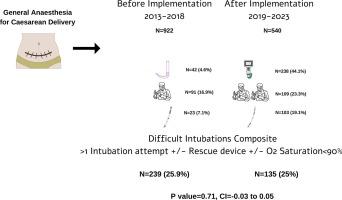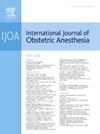剖腹产插管困难率:标准化气道管理实施前后的单中心研究。
IF 2.6
3区 医学
Q2 ANESTHESIOLOGY
引用次数: 0
摘要
背景:使用全身麻醉(GA)进行剖腹产(CD)会带来插管困难和插管失败的风险。为降低这一风险,可采用多种策略,但并非所有策略都有证据支持。我们分析了在实施针对 CD 气道管理的三项建议后插管困难的发生率:这是一项回顾性单中心研究,研究对象是 2013 年 1 月至 2022 年 12 月期间在一家三级医疗中心进行 GA 手术的 CD 病例。产后诱导 GA 或气道管理记录不完整的病例未纳入分析。我们比较了三项具体建议实施前(2013-2018 年)与实施后(2019-2022 年)的病例结果:(1) 首次尝试插管时进行视频喉镜检查 (VL);(2) 有第二名麻醉师在场;(3) 使用 6.5 毫米规格的气管导管。主要结果是插管困难,定义为综合变量(> 1 次插管尝试、使用抢救设备、SpO2 结果:我们确定了 1462 个病例,其中 922 个在实施前,540 个在实施后。插管困难的发生率相似,实施前为 239 例(25.9%),实施后为 135 例(25.0%)(p = 0.71;95% CI -0.03-0.05)。在单变量模型和调整模型中,这些建议与困难插管可能性的降低无关。结论:标准化气道管理建议的实施与降低困难插管的可能性无关:结论:标准化气道管理建议的实施对困难插管率没有显著影响,尽管三项建议的采用并不普遍。本文章由计算机程序翻译,如有差异,请以英文原文为准。

Rate of difficult intubation during caesarean delivery: A single centre before/after standardised airway management implementation study
Background
The use of general anaesthesia (GA) for caesarean delivery (CD) introduces the risk of both difficult and failed intubation. Various strategies may be utilised to reduce this risk; however, not all are supported by evidence. We analysed the rate of difficult intubation following implementation of three recommendations specific to airway management in CD.
Methods
This was a retrospective single-center study of CD cases performed under GA at a tertiary care center between January 2013 and December 2022. Cases with GA induced after delivery or with incomplete airway management records were not included in the analysis. We compared outcomes for cases before (2013–2018) versus after (2019–2022) implementation of three specific recommendations: (1) video laryngoscopy (VL) for the first intubation attempt; (2) the presence of a second anesthetist; (3) use of endotracheal tube size 6.5 mm. The primary outcome was difficult intubation, defined as a composite variable (> 1 intubation attempt, use of a rescue device, SpO2 < 90%). We conducted univariable and adjusted analyses of plausible variables associated with difficult intubation, including age, body mass index, predicted difficult airway, and each of three recommendations.
Results
We identified 1462 cases, 922 before and 540 after implementation. The frequency of difficult intubation was similar with 239 (25.9%) before versus 135 (25.0%) after implementation (p = 0.71; 95% CI −0.03 to 0.05). The recommendations were not associated with a decreased likelihood of difficult intubation in the univariable and adjusted models. Adoption of all three recommendations was significantly more frequent in the post-implementation period.
Conclusion
Implementation of standardised airway management recommendations had no significant impact on difficult intubation rate, though adoption of all three recommendations was not universal.
求助全文
通过发布文献求助,成功后即可免费获取论文全文。
去求助
来源期刊
CiteScore
4.70
自引率
7.10%
发文量
285
审稿时长
58 days
期刊介绍:
The International Journal of Obstetric Anesthesia is the only journal publishing original articles devoted exclusively to obstetric anesthesia and bringing together all three of its principal components; anesthesia care for operative delivery and the perioperative period, pain relief in labour and care of the critically ill obstetric patient.
• Original research (both clinical and laboratory), short reports and case reports will be considered.
• The journal also publishes invited review articles and debates on topical and controversial subjects in the area of obstetric anesthesia.
• Articles on related topics such as perinatal physiology and pharmacology and all subjects of importance to obstetric anaesthetists/anesthesiologists are also welcome.
The journal is peer-reviewed by international experts. Scholarship is stressed to include the focus on discovery, application of knowledge across fields, and informing the medical community. Through the peer-review process, we hope to attest to the quality of scholarships and guide the Journal to extend and transform knowledge in this important and expanding area.

 求助内容:
求助内容: 应助结果提醒方式:
应助结果提醒方式:


